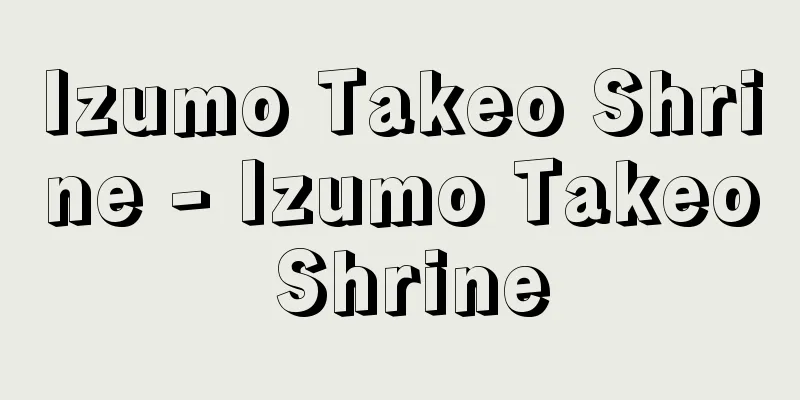Kiriyama Castle

|
This mountain castle ( Yamajiro ) was located in Tsu City, Mie Prefecture (formerly Misugi Village, Ichishi County). It is a nationally designated historic site. It was the castle of the Kitabatake clan, who were the governor of Ise during the Nanboku-cho period and the feudal lord of southern Ise during the Sengoku period. The castle was built near the top of the mountain (approximately 600m above sea level, 240m above sea level) behind Kitabatake Shrine, which enshrines Kitabatake Akiyoshi (the first head of the Ise Kitabatake clan and the builder of Kiriyama Castle. He is also said to be the third son of Kitabatake Chikafusa, but there are various theories), located about 5km east of Ise -Okutsu Station (JR Meisho Line). At the foot of the mountain, in what is now the grounds of Kitabatake Shrine, stood the Kitabatake clan's peacetime residence (also known as Tage Palace or Kiriyama Palace), and behind this residence, at the tip of the mountain ridge, was a secret castle, and further up the ridge, at the top of the mountain, stood Kiriyama Castle. The Kitabatake clan residence (Tage Palace), secret castle, and Kiriyama Castle are collectively known as Taki Castle. In 1336 (Kenmu 3, Engen 1), around the time Emperor Go-Daigo traveled to Yoshino and established the Southern Court, Kitabatake Chikafusa entered southern Ise and built Tamaru Castle (Tamaki-cho, Watarai County) as his base. In 1342 (Kōei 1, Kōkoku 3), Tamaru Castle was attacked by the Northern Court, and Kitabatake Akiyoshi fled to this place. At that time, Akiyoshi built Kiriyama Castle as his new residence. From then on, the Hatakeyama clan ruled over the five southern Ise counties, Iga Province, and Uda County in Yamato Province, until the eighth head of the Ise Kitabatake clan, Gonyo, using Taki Castle, including Kiriyama Castle, as its base. In 1569 (Eiroku 12), the lord of the castle, Kitabatake Tomonori, moved his base to Okawachi Castle (Matsusaka City) to oppose Oda Nobunaga of Owari. After Nobunaga invaded, Tomonori made peace with Nobunaga by adopting Nobunaga's second son, Nobuo, as his heir (the eldest son of the Kitabatake clan). However, in 1576 (Tensho 4), Nobuo assassinated his father-in-law, Tomonori, at Mise Mansion (Odai Town, Taki County, also known as Mise Palace). Upon learning that Tomonori had been murdered, the former retainers of the Kitabatake clan flocked to Kiriyama Castle, where their clan member, Kitabatake Masanari, was the lord of the castle. It is said that they numbered over 1,000. On December 2nd of the same year, Hashiba Hideyoshi (later Toyotomi Hideyoshi), Kobe (Oda) Nobutaka, Seki Morinobu and 15,000 other Oda troops launched an all-out attack on Kiriyama Castle. The former retainers of Kitabatake fought bravely, but the castle lord Masanari and many other soldiers were killed and the castle fell. It was subsequently abandoned. Near the top of the mountain, the remains of the castle's earthworks and moats remain, as well as a monument commemorating the castle's existence. Take a bus from Ise-Okutsu Station on the JR Meisho Line to Kitabatake Jinja-mae, or take a taxi from the station. It is about a 60-minute walk from Hizu Station on the JR Meisho Line, or about a 10-minute taxi ride from the station (both to Kitabatake Jinja). A 1.3km hiking trail is maintained from near Kitabatake Jinja to the summit, where the remains of the main castle are located. It is a 35-40 minute walk from the trailhead to the summit. At the top of the mountain there is a leveled area called the Bell Tower, and if you walk down a little from here along the ridge you will come to where the main bailey of Kiriyama Castle once stood. Source: Kodansha Encyclopedia of Japanese Castles Information |
|
三重県津市(旧一志郡美杉村)にあった山城(やまじろ)。国指定史跡。南北朝時代には伊勢の国司、戦国時代には南伊勢を勢力圏とする戦国大名となった北畠氏の居城。伊勢奥津駅(JR名松線)から東へ約5kmにある北畠顕能(伊勢北畠家初代。霧山城の築城者でもある。北畠親房の三男ともいわれるが諸説ある)を祀(まつ)る北畠神社の裏山(標高約600m、比高約240m)の山頂付近に築かれていた城である。ふもとの現在北畠神社の境内となっている場所に、北畠氏の平時の居館(多芸(たげ)御所、霧山御所とも)があり、この居館の背後の山上の尾根の先端部に詰の城が築かれ、その先の尾根沿いの山頂に霧山城があった。この北畠氏館(多芸御所)・詰の城・霧山城の3城を含めて多気城ともよばれる。1336年(建武3・延元1)、後醍醐天皇が吉野遷幸をして南朝を立てたころに、北畠親房が南伊勢に入り、田丸城(度会(わたらい)郡玉城(たまき)町)を築き拠点にした。1342年(康永1・興国3)、田丸城は北朝方に攻められ、北畠顕能はこの地に逃れた。このとき、顕能が新たに居館として築いたのが霧山城である。以後、畠山氏は霧山城を含む多気城を拠点として、伊勢北畠氏第8代の具教に至るまで多南伊勢5郡および伊賀国、大和国の宇陀郡を治めた。1569年(永禄12)、城主の北畠具教は、本拠を大河内城(松阪市)に移して尾張の織田信長に対抗した。その後、信長の侵攻を受け、具教は信長の次男信雄を養子(北畠家の嫡子)とすることで和睦した。しかし、1576年(天正4)、信雄は義父・具教を三瀬館(多気郡大台町、三瀬御所とも)で暗殺した。具教が殺害されたことを知った北畠氏の旧家臣は、一門の北畠政成が城主をつとめていた霧山城に続々と集結した。その数は1千余といわれている。同年12月2日、羽柴秀吉(のちの豊臣秀吉)・神戸(織田)信孝・関盛信ら織田軍1万5000が霧山城に総攻撃を行ったといわれている。北畠の旧臣は奮戦したが、城主・政成はじめ多くの将兵が討ち死にして落城。その後、廃城となった。山頂付近には霧山城の土塁、堀切などの遺構が残っているほか、城があったことを記した碑が建っている。JR名松線伊勢奥津駅からバス、北畠神社前下車、あるいは同駅前からタクシー。JR名松線比津駅から徒歩約60分、または同駅からタクシーで、約10分(いずれも北畠神社)。北畠神社近くから主郭跡のある山頂部までは1.3kmのハイキングコースが整備されている。登山口から山頂部までは徒歩35~40分。山頂に鐘撞堂と呼ばれる削平地があり、ここを尾根沿いにやや下ったところが、かつて霧山城の主郭のあったところである。
出典 講談社日本の城がわかる事典について 情報 |
Recommend
Uwamizuzakura - Uwamizuzakura
A deciduous tall tree of the Rosaceae family (APG...
Paint and varnish
A general term for a liquid substance that is spr...
via negativa (English spelling) via negativa
…The knowledge of God must be the knowledge of ig...
Anjou blanc (English spelling)
...The western region, which is part of the Armou...
Okayama Prefecture
A prefecture in the eastern part of the Chugoku re...
Gold sensitization
A typical method of chemical sensitization in whic...
Katsunori Minoura
Year of death: August 30, 1929 Year of birth: Febr...
crusher
…Therefore, in the broad sense, mortar refers to ...
Colchicum
...Autumn-planted bulbous plant of the genus Colc...
Ako Misaki
A scenic spot in Ako city, on the southwestern ti...
Indian rat flea - Indian rat flea
... House mice are often infested with the Japane...
Listera makinoana (English spelling) Listeramakinoana
… [Ken Inoue]. … *Some of the terminology that me...
Piper retrofractum
… [Mitsuru Hotta]... *Some of the terminology tha...
Ikinomatsubara - Ikinomatsubara
A pine grove on the coast of Sawara County, Chikuz...
Koji Gushiken
1956- A gymnastics athlete and coach from the lat...









